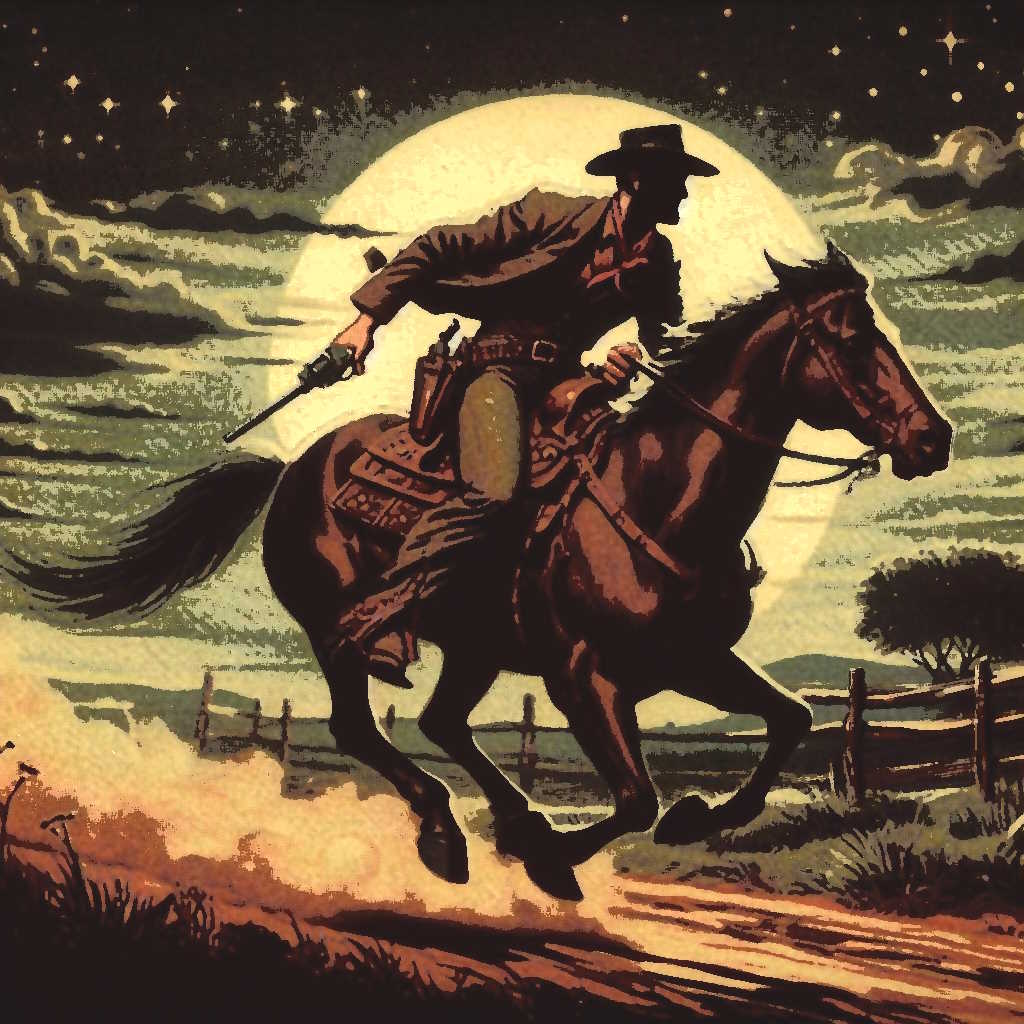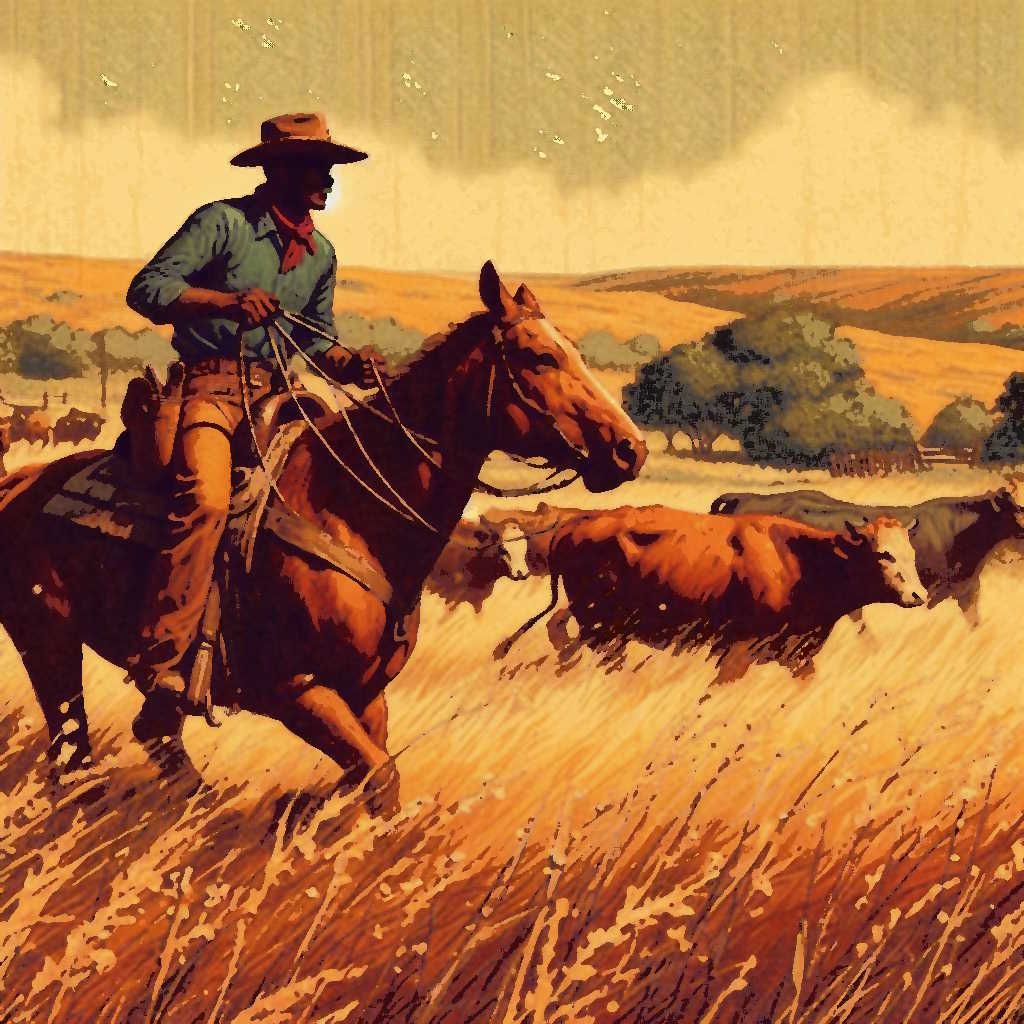
MUCH as the swift-moving Western story offends the ultra-cultured tastes of the intelligentsia, it has made for itself a very definite place in American literature. It may not be “art,” as the literati consider art. It may lack the polish of urban tales or the heart-throbs of bucolic stories. But it has something of which neither of these can boast. It has action; action to the nth degree! And it is typically American. Its popularity with the reading public is evidenced by the fact that today it is one of the very few types of adventure stories to which entire magazines are devoted.
Critics of the “Western” are legion. Because of its swift action and original diction, they concede it to be nothing better than the progeny of the Diamond Dick and Nick Carter yarns. Yet the Western is no more the offspring of the Diamond-Dick thriller than our tales of the sea are kin to the old “paperbacks” that once luridly detailed the harrowing exploits of the buccaneers.
Tainted, then, as the Western is by the Diamond-Dick thrillers, critics years ago predicted its summary demise. Yet the Western today is riding “high, wide, an’ handsome,” and new magazines are appearing almost monthly in its name.
The chief objection to the Western, it seems, is its speed of action, which precludes all chance of “letting down.” This was made clear to me recently when I submitted a Western novelette to a well-known “book-paper” magazine. In rejecting it, the editor wrote: “Your canvas is too crowded. While I realize that there are many industrious writers who make a living writing this fast moving, vivid type of story, it fails utterly to touch the gold with us.”
A matter of policy, perhaps! At least, a problem that every writer of Western fiction faces constantly. His yarns are too breath-taking, critics say. Are they, or does the stigma of the Diamond-Dick thriller still cling to the “Western”?

Westerns must, of necessity, be fast-moving, for the life of the West was that way. The cowboy was a man of few words but great action. He lived in the saddle and was always on the move. The problem he faced was weather — terrible, death-dealing winters and blistering, rainless summers. The things he fought for were the two essentials of life — food and water. The men he was pitted against were, in many cases, fugitive desperadoes who bowed to no law save that which the cowboy “toted” on his hip. Small wonder then that the tales of the “puncher,” who was up with the break of dawn and away, never to stop moving until long after dark, are filled to the brim with action!
If this be the age of speed, then the Western truly belongs. For in it there Is no attempt at slow, monotonous characterization. Characterization is supplied by action. If there be description, it is short and vivid, as the cowboy saw it.
Much has been said concerning the improbability of Western stories. As a writer of Western fiction for ten years, I have never based one of my stories on anything but fact. Nor do I believe that other Western writers are fictionists in the sense of fabricating impossible situations. Somewhere in the wildest, swiftest-moving Western will be found an element of truth.
All cowboys were not hard-shooting, hard-drinking renegades, as many Westerns picture them. That is admittedly true. But, on the other hand, the cowboy was no angel. He was a victim of environment. Working as he did on the silent’ trails, miles from the crude civilization of the plains, his only companions dumb brutes, when finally he did get among men, he did what the sailor does, what the soldier does, what any red-blooded human being does — he unleashed his pent-up passions and “cut loose.” And limited as were his recreations, he naturally took advantage of the few offered.
Westerns have been maligned for their alleged evil influence on hero-worshiping youth. If this be true, then writers of every kind of adventure story are guilty on the same score. But of all the rest. Westerns are singled out as the target for critical shafts, because they still carry the taint of the Diamond-Dick thrillers.
There have been, indisputably, many great Western stories. Of these, Wister’s The Virginian is probably the greatest. We have all thrilled to the lazy drawl of the Virginian. He was of the West, an example of what the Westerner should be, the critics claim. Yet, strange as it may seem, that same Virginian and his soft speech are to blame for most of the crimes committed in the name of Western fiction today. That Virginian has all but succeeded m corrupting the language of the West — “as she is writ,” as Mark Twain might have said.
As is true with every other class of stories, there are writers of Westerns whose knowledge of the great prairie has been obtained from that area lying east of the Alleghanies. These writers have taken the Virginian who, it must be remembered, was a Virginian and not a Westerner— and put his slurred “r’s” and soft drawl into the mouths of their cowboys. The result is a jargon of deliberately misspelled words under the guise of dialect, and no more resembling the vernacular of the West than many of the gaudily-dressed and swaggering cowboys they would have folk believe infested the range. Many of the heroes of Westerns today would have been hanged forthwith had they ever dared to show up in a real cow camp.
The Westerner was once an Easterner. Many of the “wagon bosses” on the roundups wore fraternity pins on their horsehide vests and had diplomas from large universities tucked away in their “warbags.” Eventually they came to drop their final “g’s.” Soon they included in their vocabulary a few of the cowboy’s original words, which in many cases he coined to express something briefly, rather than be bothered with discussing it at length. But the cowboy talked like a human being fifty years ago, and, strangely, still does today. Simply because the Virginian, first great hero of Western fiction, said “yuh” and “suh” is certainly no sign that real Westerners should continue to say the same thing indefinitely in stories.
The cowboy has put several words into the language that will endure. He was, first of all, a man who expressed himself swiftly and tersely. To this end he dropped many words of common usage and coined others to express his thoughts. He was essentially a coiner of phrases — short, powerful, and descriptive.
I have often wondered if the critics of Westerns know anything of the West? When they complain of the vernacular, of the breathlessness of these yarns that never “let down,” do they realize that the cowboy himself never “lets down”? That, when men of other sections were in the prime of life, the cowboy was so badly “stove up” as to be no longer classed as a “top hand”? The life of a cowboy was truly fast and furious, as the Western story paints it.
Few readers realize the rigid demands imposed upon a writer of Western fiction. First of all, to be true to life, the story must be fast-moving. It must have, of course, the vital elements of suspense and mystery. To produce a salable script, the writer of Westerns must incorporate the requisites of other short stories and stretch his imagination back forty years for a setting, for editors will not admit that the West of the old trail-herd days is dead. This is not required of the writer of rural stories, of urban yarns, of other types of adventure yarns. They have their locale, the same now in most respects as it was a half century ago.
But the trail herds have vanished. What few cowboys are left wear mail-order clothes. The “bronc-peelers” long since have quit the “home ranch” for the rodeo game, leaving the writer stranded high and dry for a background for his fast-moving Westerns, which, undeniably, have created a new field of fiction — a type of story that, above all else, is typically American, and which in its typically American way defies all precedent, smashes all the rules of good writing, and utterly Ignores the example set by the masters of another age!
— Francis W. Hilton.